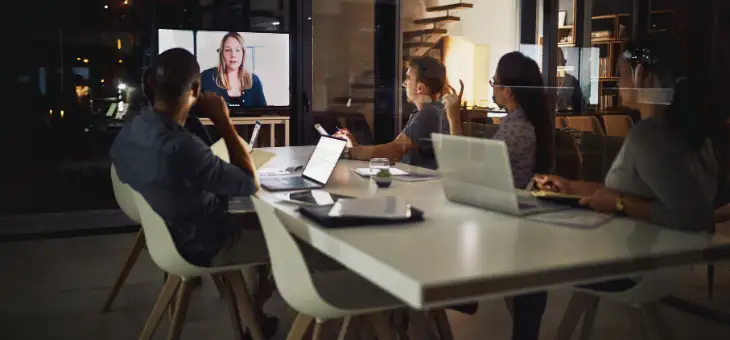Improving Employee Experience as they Return to the Office
The well-being of employees has never been more critical. Employee experience, of course, refers to their interpretation of their journey at work. It involves all aspects and
Read more
As remote work grows, collaboration has become more and more of a buzzword. But are we sure any more how to get it right?
Our ideas of how to collaborate have certainly had a shakeup during the pandemic, and will probably never be the same again. It’s become apparent that online collaboration can be rich and effective – but it’s become equally apparent that it’s not always the be-all and end-all.
So we need to rethink collaboration, what it means to us and how we go about it every day. Because good collaboration will always be one of the biggest keys to success for any organization.
Why collaboration matters
Fostering collaboration is crucial when it comes to improving employee productivity. A study of 1100 companies by the Institute for Corporate Productivity found that those organizations that promoted collaborative working were five times more likely to be high-performing.
On the downside, a breakdown in communication and lack of collaboration in an organization leads to misunderstandings, delays, errors and inefficiencies that negatively impact productivity.
Now that collaboration takes place increasingly in the digital realm, it takes special attention to make sure that sort of breakdown does not occur.
1. It breaks down corporate silos by helping team members communicate across departments.
2. It helps promote innovation and agility because employees can develop ideas quickly and to tap into talent across the organization.
3. It streamlines workflows by improving communication among departments, creating an agile organization that can respond to market demand cost-efficiently.
4. It increases transparency and visibility in projects by maintaining an open line of communication.
5. It promotes team problem-solving, especially for remote workers, by allowing employees to meet, discuss and make decisions with agility and accuracy.
Ultimately, creating engaged teams leads to happy and satisfied workers who are much less likely to burn out or, worse, leave!

Making way for a return to work
While the return to work may not happen as quickly as some predicted in 2021, when it happens it could usher in a new “digital” industrial revolution.
McKinsey reports that some executives already say they moved 20 to 25 times faster than they thought possible during the pandemic in areas like building supply-chain redundancies, improving data security, and increasing the use of advanced technologies in operations.
Covid quickened the adoption of collaborative technologies such as Zoom, thanks to the move to remote working, but going to take more than Zoom to facilitate the safe return to work and normal productivity. There are a lot of constituent elements in the workplace – meeting rooms, hot desks and breakout areas – and not all interaction can, or should, be digital. Also, mental health is a key driver – workers are less likely to be productive in a workplace where they feel unsafe.
Top tips for the continued return to work
Safe desking – staff can use a mobile booking app to safely book a desk using a graphical floorplan which that reflects the distancing and cleaning status of desks. A unique “find a colleague” feature enables workers to quickly find team members so they can collaborate efficiently and safely.
Safe meetings – face-to-face time is important for sparking ideas. Meeting room booking software can be used to control the number of people in a meeting so that you can still meet and thrash out new innovative ideas – safely. Occupancy sensors can also be deployed to maintain safe occupancy levels in meeting rooms.
Safe cleaning – Cleanliness is key in attracting and reassuring staff in their return to work. The meeting room and desk booking software automatically mandates that extra time is allocated to the cleaning of desks and meeting rooms. This is communicated automatically to service staff via email. Integration with desk sensors and room panels ensures staff know which areas are out for cleaning.
Safe video conferencing rooms – the use of video conferencing has exploded in the past year. Integration of meeting room booking software with Team/Skype/Zoom-enabled rooms means that even the most complex meetings can be organised quickly. Starting the meeting is simple – just a quick tap on the room panel. Further integration with voice assistant apps like Cortana makes it even faster to start a VC meeting.
Touch-free hot desking – for the ultimate in ease of use, sensor technology enables staff to identify an available hot desk or work area using a graphical signage board. The check in/out process is simple – the staff member walks to the desk, sits down, does their work and then leaves – the motion sensor technology takes care of everything. As the sensor technology is based on real-time occupancy it produces invaluable data for future real estate configuration decisions.
QR code based access – desks and meeting rooms can be checked in and out quickly using QR code scanning in our mobile app. Scan the code on the desk or meeting room using the app to check in and repeat the process on the way out.
RFID access – taking things one stage further, access via RFID cards means staff can check into the building, then the desks or meeting rooms using an RFID card – the ultimate in no touch access. Start a meeting safely by tapping the RFID enabled digital signage.
Conclusion
Creating a safe and touch-free access workplace is crucial to making the return to work as frictionless as possible. At the same time, staff need access to a wide range of collaborative working styles – not all collaboration can happen over Zoom, and nor should it.
The workplace has changed and its role will be different going forward – becoming more of an occasional destination for collaboration and training than a daily destination for the 9 to 5 grind.
You need to have workspace technology needs to be in place that is flexible enough to navigate this new landscape while creating an easy to use process.
Efficiency is key – technology gives your people a great digital experience that enables them to get into the building and get on with their work in the most productive way possible of their choosing.
After all, knowledge workers should be using their minds for having great ideas – not for worrying about how to find a safe place to work.
See how this technology works in practice and delivers great – collaboration – check out our IDC case study video.